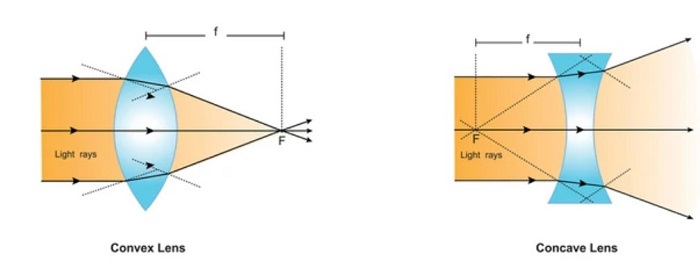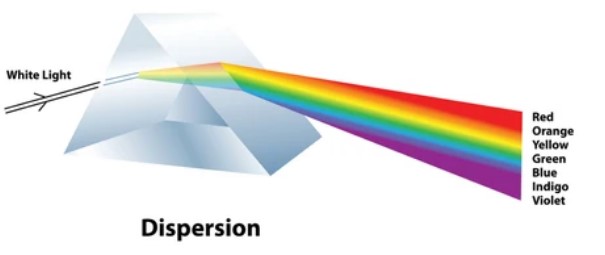Images Generated by Lenses
Since a lens is composed of a single piece of transparent glass sandwiched between two spherical surfaces, light may travel through them and we are able to see through it. There are two kinds of lenses; namely, convex lenses and concave lenses.
Some lenses are thicker in the center than they are at the edges, while others are thinner in the center than they are at the edges.

Convex Lens (Converging Lens)
The convex lens is the lens that has a greater thickness in the center of the lens compared to the thickness at the lens's edges. When a beam of light composed of parallel rays strikes a convex lens from the left, the parallel light beams converge at a single point. This is the reason why a convex lens is referred to as a converging lens.
Image created by a convex lens
The object's distance from a convex lens determines the type and size of the picture created by the lens.
When an object such as a candle is positioned at a great distance from a convex lens, the resulting picture is real, inverted, and considerably shorter than the object itself (or highly diminished).
Now, move the candle such that its flame is always in focus on the screen by varying the distance between the candle and the lens. So, is it feasible to get the object in a place in which the image seems to be upright and magnified? Yes, if the candle is positioned in close proximity to the convex lens.
Application of Convex Lenses
⦁ Magnifying glasses, consisting of convex lenses, are employed in optical equipment.
⦁ Convex lenses are used in the manufacture of eyeglasses, cameras, microscopes, telescopes, and binoculars.
Concave Lens (Diverging Lens)
In a concave lens, the center is narrower than the edges. When a parallel light beam strikes a concave lens, the light beams begin to diverge (or spread out). Since a concave lens causes light rays that strike it to diverge, it is also known as a diverging lens.
A Concave Lens Produces an Image
We have determined that the nature of the image created by a convex lens changes with the distance between the lens and the object. However, the same is not applicable when we take concave lenses under consideration.
Let us do an activity to understand what kind of image is formed by a concave lens.
1. A concave lens is mounted to a supporting base and kept on the table.
2. A 20 cm x 15 cm piece of cardboard has to be taken, and a white sheet is glued to it. This combination will serve as the screen for the experiment.
3. A lit candle is positioned at a predetermined distance from the concave lens. The candle is positioned on the opposite side of the lens, and its position is adjusted to provide a clear image of the flame on the screen.
4. Not only the candle but also the screen distance has to be changed to get a decent image on the screen.
Observation
Regardless of the object's distance from the lens, the resulting picture will always be virtual, upright, and considerably smaller (or much decreased) than the object itself.
Uses of concave lenses
⦁ These concave lenses are used in door viewers and peepholes to get a view of the person standing behind the door.
⦁ They are also used in flashlights to spread the light across a larger region.
⦁ Based on the eye problems, it is also used to correct eyesight using eyeglasses.
Sunlight is either white or colored - which is true?
To understand whether sunlight is white or colored, let us consider the example of a rainbow, which often comes after rain and when the sun is low in the sky. The rainbow, a natural phenomenon, is a wonderful example of how light is composed of several colors. A rainbow is a broad, multicolored arc in the sky, and when different lights combine, they produce white light. We shall learn more about it in the following topics of rainbow formation and dispersion of light.
Understanding how are rainbows formed?
A huge number of minute droplets will be present in the air after precipitation. Through these droplets, white light from the Sun penetrates and disperses into seven colors. These seven hues break out after passing through the raindrops to form a rainbow.
Similarly, when we blow soap bubbles, they likewise seem multicolored. Similarly, when light reflects off the surface of a Compact Disc (CD), several colors are seen. The rainbow is caused by the dispersion of sunlight by suspended raindrops.
Light's Dispersion

Newton discovered in 1665, via experiments using glass prisms, that white light (such as sunshine) contains a blend of seven colors. Newton discovered that when a beam of white light passes through a glass prism, it divides into seven distinct colors on a white screen.
A glass prism is an optical substance that is transparent with a flat base and polished surfaces on all sides.
When a beam of white light is transmitted through a prism, it is separated into a range of seven colors known as the spectrum of light -- namely, Red, Orange, Yellow, Green, Blue, Indigo, and Violet.
Therefore, dispersion of light is the phenomenon that occurs when white light passes through a transparent material such as a glass prism and splits into seven hues.
Seven-color spectrum creation shows that white light is a blend of seven hues. To be specific, sunlight consists of white light which splits into seven colors when the beam of sunlight falls on a prism or raindroplets. So, we can now say that sunshine comprises seven hues, and when these colors are combined, they produce white light.
To know more about types of lenses; rainbow formation, or dispersion of light, you can check our videos.


